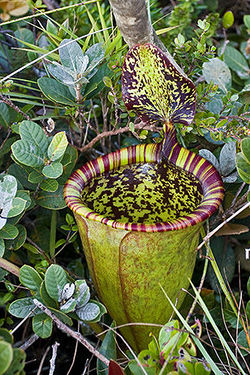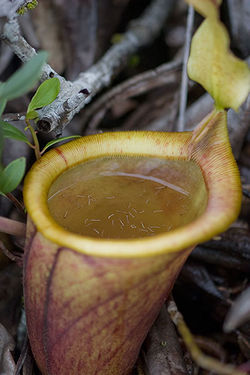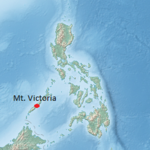Attenborough's pitcher plant
| Attenborough's pitcher plant |
|---|

|
| Scientific Classification |
|
| Binomial Name |
|
N. attenboroughii |
| Lower pitcher containing an infauna of mosquito larvae. |
Attenborough's pitcher plant is a species of carnivorous pitcher plant known by the scientific name N. attenboroughii. It was recently discovered on Mt. Victoria, the Philippine Island of Palawan in 2009. This plant was named after the celebrated broadcaster and naturalist Sir David Attenborough, who is an expert on these carnivorous plants. Attenborough's pitcher plant is currently listed as critically endangered. This is not surprising since it is only native to a single mountain on an island. Like other plants, it still performs photosynthesis for energy. Because of the nutrient deprived soil Attenborough's pitcher plant lives in, it must capture and digest other organisms to gain nutrients. Attenborough's pitcher plant is also the largest species of pitcher plants and specializes in consuming vertebrates along with insects and spiders.
Body Design
N. attenboroughii is a terrestrial upright or scrambling shrub. The stem, which may be up to 3.5 cm thick, is circular and reaches heights up to 1.5 m. The leaves are leathery and sessile. The leaves of rosettes are up to 30 cm long and 10 cm wide, whereas those of the scrambling stem are up to 40 cm long and 15 cm wide. The leaves are oblong to elliptic, obtuse at the apex and shortly slender at the base, clasping the stem by approximately two-thirds of its circumference and extend down the stem for 2–3 cm. N. attenboroughii produces some of the largest pitchers in the genus, sometimes exceeding those of typical N. rajah in size. The largest recorded pitcher of N. attenboroughii measured more than 1.5 liters in volume, and traps exceeding 2 liters are likely to be produced on occasion. The lower pitchers are brittle and bell-shaped, up to 30 cm tall and 16 cm wide and emerge from tendrils that are 30–40 cm long and 4–9 mm in diameter. The tendrils are flattened towards the leaf, making them almost semi-circular in cross section.[2]
N. attenboroughii has a inflorescence(cluster of flowers) up to 80 cm long. The male flower spike bears approximately 100 pedicellate flowers on a rachis up to 45 cm long and is recorded to divide into multiple branches on occasion. The flowers lack bracts and produce red tepals that are broadly ovate with an obtuse apex. The female inflorescence is shorter, to 65 cm long, never divides, and bears up to 70 densely arranged flowers on a compact rachis up to 20 cm long. The tepals are brown to purple, ovate, and have an acute apex.[3]
Life Cycle
The life cycle of Attenborough's pitcher plant is like any other pitcher plant. Once a flower is fertilized by the pollen of another plant, it will begin producing seeds that are transported by the wind. The seeds fall to the ground and, if there is plentiful light and moisture they germinate. Pitcher plants grow slowly, taking roughly a full year for a germinated seed to grow 1 inch.
Initial Growth
Over the next few years, the pitcher plant grows and disperses roots. Pitcher traps start out as specialized leaves that grow outward, down and away from the stem of the plant. Gradually, this specialized leaf or petiole expands to form an inner chamber. The edges grow flanges and the inner surface secretes a slippery liquid. When fully formed, the lid of the pitcher pops off, releasing the scent of nectar to attract prey.
Second-Stage Growth
Once the pitcher has fully formed and prey have begun to provide additional nutrients to the plant,climbing stems appear. These stems grow like vines, crawling up nearby trees or other structures, seeking more light. They also provide support for the pitcher during development. If the stems do not find support, they swell to become pitchers themselves. Climbing pitchers are different from ground pitchers. They are longer, lighter, and thinner than their more bowl-shaped and ground-based companion.
Decomposition
As the pitcher plant reaches the end of its life, it begins to dry out. Often times the dried pitcher will become the home for many insects and will contribute its nutrients to the surrounding soils as it decomposes.[4]
Ecology
Attenborough's pitcher plant is known only from Mount Victoria in central Palawan, Philippines. It is found on the mountain's slopes from 1,600 m to the summit. Three colonies are now known, but the total area occupied by the species comprises a few hundred square meters on each side of the summit region. Plants grow singularly or in sparsely scattered groups of a few individuals with a density less than one plant per 20 m². Therefore the known population of three colonies consists of only a few hundred individuals.
This carnivorous plant grows on nickel/magnesium-rich soils only, and mainly in high altitude shrub land. The species consists of male and female plants, with a slight male bias. Any decrease in the population will have a greater impact on reproductive potential because these plants cannot self pollinate or reproduce asexually.[5]
Carnivory
Pitcher plants all get their names from their pitcher shaped pitfall traps. These traps release a nectar that attracts prey like insects, spiders, frogs and even small rodents and birds. The leaves are slippery on the inside, causing the prey to lose its footing and slip inside. Once prey is secured the plant secretes digestive juices and consumes it live. Because Attenborough's pitcher plant is so large it specializes in vertebrates, eating primarily birds and rats.[4]
Video
Attenborough's pitcher plant digests a shrew.
References
- ↑ Attenborough's pitcher plant Wildscreen Arkive . Web. 17 May 2015
- ↑ Nepenthes attenboroughii Tropical Plant Book. Web. 17 May 2015.
- ↑ spectacular new species of Nepenthes L. (Nepenthaceae) pitcher plant from central Palawan, Philippines Wiley Online Library . Web 18 May 2015.
- ↑ 4.0 4.1 Murray, Ann. The life cycle of a pitcher plant eHow. Web. 25 May 2015.
- ↑ Nepenthes attenboroughii Red List. Web. 25 May 2015.



